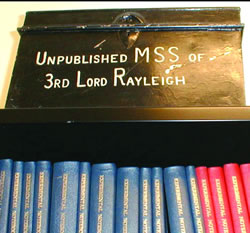A Rayleigh Miscellany

It may not be widely known that Rayleigh's notebooks, beginning as a student at Cambridge in 1862, reside at the library of the U.S. Air Force Academy, for an interesting reason. Physicists at what is now called the Air Force Research Laboratory used airglow measurements to track the effect of solar activity, but had no data prior to 1950. They learned that Rayleigh's son, the 4th Baron Rayleigh, had made almost daily measurements from 1920 until his death in 1947. They were able to purchase his notebooks in a lot that included those of his more famous father, the final entry being in March of 1919, shortly before Rayleigh died. The collection includes many letters, papers related to invention of a foghorn, the laboratory notebook of Rayleigh's sister-in-law (beginning "Cavendish Laboratory, April 1880"), and a metal box marked "Unpublished MSS of 3rd Lord Rayleigh" in which only a few fragmentary handwritten pages are found.
Foreign to me is the interest in spiritualism, séances, and psychical research of their time. Though skeptical, Rayleigh was President of the Society for Psychical Research in 1919, and his physicist son more passionately in 1937. Toward the end of his life the son gave £1000 to the Society, saying that his gift was more likely to bear fruit in this field than in any of the more orthodox branches of science.
Thomas Miller
Lexington, MA
Doing Science "Online"
There is an interesting footnote to the article "Lord Rayleigh and the Discovery of Argon" in the August/September APS News. When Rayleigh and Ramsay were working on the problem in their respective laboratories (Ramsay at University College London), they exchanged results by telegraph–perhaps the first example of scientific collaboration in the digital age.
David R. Lide
North Potomac, MD
Clarifying the Record on the SSC
I am quite tired of being the only physicist quoted in assigning the blame for the demise of the SSC, in the history column in the October APS News, as in much of the publicity surrounding the recent award of the Nobel prize. This is extremely unfair, for one because my only public testimony on the subject was for a Senate committee, and it was the House of Representatives which took the crucial vote. Several other prominent physicists had testified before the House committee, including the then President of the APS.
One of the main points of my testimony was the extreme jingoism to which the selling of the project seemed to appeal; in my testimony I argued that such a large project should properly be done under international auspices and with less of a gung-ho attitude, as it has successfully turned out. As it is, I have been able to be sincere in congratulating the high-energy community on a job very well done, in discovering the Higgs particle in which I have a very personal and continuing interest.
The depth of our feelings about the PR surrounding the selling of the SSC and in particular their claims about "spinoffs" may be understood in the following anecdote: As I was leaving the committee room behind Steve Weinberg, the particle physicist who had testified for the SSC, one of the senators accosted him and effusively thanked him for his role in the development of MRI, which had been instrumental in treatment of a relative. Since close friends and I had been responsible for most of the basic research underlying MRI's superconductiing magnets, this was a bit of a bitter pill for me to swallow. In the end, the Senate committee came out quite favorable to the SSC.
Philip W. Anderson
Princeton, NJ
©1995 - 2024, AMERICAN PHYSICAL SOCIETY
APS encourages the redistribution of the materials included in this newspaper provided that attribution to the source is noted and the materials are not truncated or changed.
Staff Science Writer: Michael Lucibella

